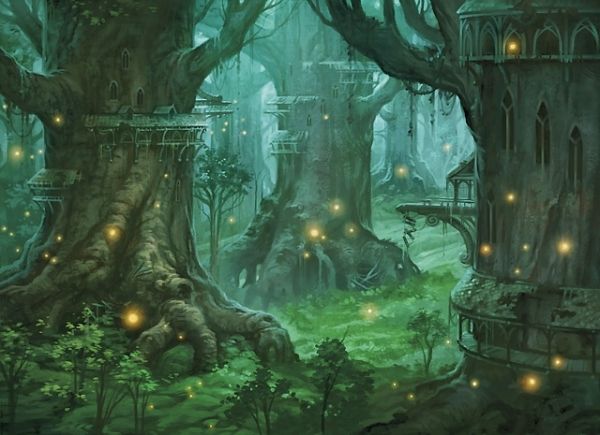Elf
A beautiful race of warriors and mages, this people is noted for their preference for deep woodlands and forests
Elves worship the The Great Powers, and consider The Traveler to be their patron. The Elven priesthood congregates outdoors in glades with wood pillars carved to represent his different aspects.
Basic Information
Anatomy
Biological Traits
Growth Rate & Stages
Ecology and Habitats
Additional Information
Social Structure
Because of the low birth rates and the individualistic personalities, the basic social unit is the couple/immediate family (which usually does not include siblings).
The individualism of Elves manifests itself in Elvish political organization. Elvish settlements are freeholds, and Elvish government is a basic decentralized representative democracy. Representative bodies are usually some sort of Council of Elders for the appropriate area advised by a priest.
Elves do not really see themselves as under the authority of human nations, and hold only to their own councils. To Elves, it is rather absurd to pledge themselves to what they see as such short lived monarchs. Most major diplomatic incidents come from elves acting on cultural knowledge learned from their youth that is no longer remembered by the current humans in the area. This can be very confusing to feudal monarchist humans. Crisis leaders are appointed at the appropriate levels to deal with emergencies that require fast action.
Geographic Origin and Distribution
Perception and Sensory Capabilities
Civilization and Culture
Naming Traditions
Gender Ideals
Courtship Ideals
Relationship Ideals
Average Technological Level
]Elven culture has achieved a late Medieval level of technology. Settlements are primarily agricultural, with small-scale agriculture, some livestock, and a significant amount of hunting and gathering for the level of technology. They are often surrounded by a grove of Starfuit Trees with Elf Berries planted under them.[/p
Livestock-wise Elves do not tend to have pasture animals in their forested environment. The exception being horses, which Elves have taken very well to. Chickens seem to be a ubiquitous livestock animal for all people and the Elves are no exception. Also they seem to have embraced pigs an animal native to Kementari. Finally, they also tend to have Elvish Dire Chickens nearby.
One Kementari crop the Elves have embraced is grapes. Elven wines are legendary amongs the other races as the highest quality wines around.
Elven cuisine often involves a truly astonishing amount of jam. So many of their crops are fruit trees or berries and are stored as preserves. The average Elf is likely an expert on the quality and preparation of jellies. Also, much of their meat is dried and/or smoked to preserve it.
Contrary to popular belief elves do not live in hollow trees... They build houses like everyone else. They do, however, tend to build them IN the trees, specifically in the canopy around the trunk.
Culture and Cultural Heritage
Common Customs, Traditions and Rituals
History
In 3900 B.C., the Elves fled to Kementari from Minyabar, after being driven from their homeland in Aelfheim by massive humanoid invasions.
According to their records, the Elves had a rough time after landing in Kementari . The Dwarves disembarked and immediately headed to unwanted mountaintops, and placated the local humans with masterwork items. As a result, they were welcomed with open arms. Elves however... not so much. Not all Humans, or even Halflings welcomed the newcomers claiming their forests. Elves generally were victorious in these skirmishes, but due to their long-lived and slow growing population each loss was felt far more heavily. There was some doubt if the exiles had escaped death from Tumo, only to die from slow attrition. The Dwarves however, came through… They repaid the debt that they owed the Elves for taking them across the portals from Berghiem to Kementari by brokering peace between the other races and the Elves.
Historical Figures
Common Myths and Legends
Interspecies Relations and Assumptions
Elves are a distant people, their long lifespans affecting their outlook. Elves by their nature tend to look at events far more objectively than the other races. This is often mistaken by members of other races as apathy or arrogance.
One thing most Humans do not really appreciate is that most Elves seen outside of their communities and among the Humans are still considered very young by the Elves. They go forth, travel, make friends, and then watch their friends grow old and die. After losing their youthful companions they often return to their forests, wanderlust quenched, and focus on making friends with those who have similar lifespans. This leaves Elves a fairly insular people that do not tend to take part in the local political landscape- preferring to ignore the rest of the world when possible.
Elves often trade with those around them, but relationships remain professional and true friendships between Elves and outsiders are rare.
Of all other races, they actually get along best with the Dwarves, not only because of they shared hardships of the exile, but because being a long lived, culturally slow changing people, dealing with Dwarves remains a familiar experience. It is not uncommon for a Dwarf speaking with Elves to respond to their father’s, or even grandfather’s name without comment. It is easy to see a few descendants as copies of their friends of youth.
Remove these ads. Join the Worldbuilders Guild



Comments